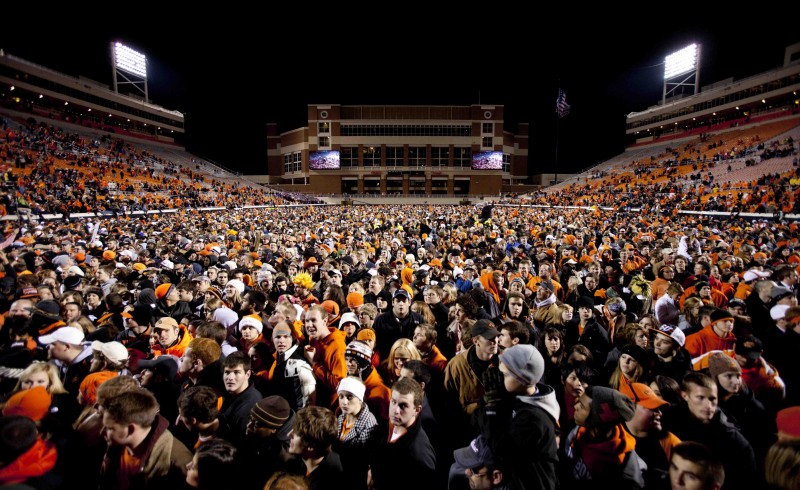Football
A note on the OSU defense: this isn’t 1994
Has Oklahoma State’s defense been inept? No, not even close.
Earlier this week John Hoover wrote a semi-scathing column in the Tulsa World on the Oklahoma State defense under Mike Gundy. He called OSU’s defense “mediocre” and said “count on two things every year in the Big 12 Conference: The Cowboys’ offense is going to be very good and the Cowboys’ defense is going to be very bad.”
Now I don’t disagree with parts of that — OSU has had pretty bad defenses in the past, even the recent past.
But his premise for how you judge a defense is a little silly.
He cited total defense (total yards given up), passing defense, and rushing defense as three of the prime indicators for whether or not a defense should be considered “good.”
As I said in the headline my problem with this is that we live in the year 2013, not 1994.
Hoover also said that 2009’s version was the best of the bunch since 2002. You know what happened in 2009 that he failed to mention? OSU’s offense played slow in 2009, of course the defense was going to look better — they were rarely on the field.
For the sake of comparison:
2012 defense: 1034 plays
2011 defense: 1089 plays
2010 defense: 1069 plays
2009 defense: 919 plays
120+ plays in a season doesn’t seem like a lot but when the median in college football is around 900, I mean, we’re talking over 10% of your season, another game and a half worth of plays. That seems like it should matter when you’re trying to determine how good a team is by how many total yards they give up.
We digress though — and that 2009 defense actually was pretty good, but not because it was ranked better in total yards given up than in other seasons (I’ll show you this in a minute).
Using yards allowed and points allowed on their own to determine how good a defense is in 2013 is just plain silly. Especially when we have the data to look at yards per play and points per possession and things like where your offense left the ball for your defense to take over and garbage possessions and on and on and on.
It’s like saying because Dustin Johnson hits his drives farther than anybody else, he should be the best golfer in the world.
Judging a team based on total yards or total points completely takes pace of play out of the equation so you can’t fairly compare a team like OSU’s (who plays hyper-fast and puts its D on the field so much) and a team like LSU’s (pretty much the opposite).
First, just to debunk the total yards given up thing. Here are OSU’s numbers in yards per play the last six years (national rank in parentheses):
Yards per play
2007: 5.9 (101)
2008: 5.6 (94)
2009: 4.7 (16)
2010: 5.0 (28)
2011: 5.5 (59)
2012: 5.3 (42)
So you can see the 2007 and 2008 teams were terrible but the last four have actually been pretty decent. Not great, not elite, but definitely not “very bad.” Also, guess when Bill Young got to town….
Now, let’s look at Defensive FEI. That’s just an acronym to you, I know, so I’ll try to explain.
DFEI on Football Outsiders is defined as this: the opponent-adjusted efficiency of the given team’s defense.[1. FEI (and thus Defensive FEI) is a college football rating system created by Brian Fremeau based on measuring the success rate of a college football team scoring and preventing opponent scores during the non-garbage possessions of a game. FEI rewards playing well against good teams, win or lose, and punishes losing to poor teams more harshly than it rewards defeating poor teams. It is drive-based, not play-by-play based, and it is specifically engineered to measure the college game. You can read more about all the factors that go into it here.]
It takes into account things like:
• Actual drive success of its opponents against expected drive success based on field position.
• Percentage of opponent offensive drives that result in at least one first down or touchdown.
• Yards earned by the opponent offense divided by the total number of yards available based on starting field position.
• Percentage of each opponent offense’s drives that average at least 10 yards per play.
• Defensive Strength of Schedule
It’s essential premise though, is did you stop people from scoring?[1. Last time I checked, this was the point of a defense.]
This is OSU’s national rank the last few years (not Big 12, national):
DFEI
2007: 79
2008: 84
2009: 21
2010: 23
2011: 3
2012: 30
Bad in 2007 and 2008 (as we thought) but then pretty freaking great in 2009-2012. Like, top 30 great. And that 2011 defense was only bettered by LSU and Alabama. Only bettered by LSU and Ala-freaking-bama.
This is not a perfect indication of how good a defense is, but it is certainly better than looking at a total yards column, sorting by “descending,” and rolling with that. Way better.
About 2011 Hoover says turnovers that season simply hid a decade of ugly truth: Oklahoma State’s defense stinks.

-

 Wrestling3 days ago
Wrestling3 days agoThe Top 5 Quotes from John Smith’s Retirement News Conference
-

 Football4 days ago
Football4 days agoWide Receiver Prospect Kameron Powell Commits to Oklahoma State
-

 Hoops4 days ago
Hoops4 days agoReport: Former Arkansas Guard Davonte Davis to Visit Oklahoma State
-

 Wrestling3 days ago
Wrestling3 days agoOSU Wrestling: The Impact John Smith Had on His Final Boss, Chad Weiberg







